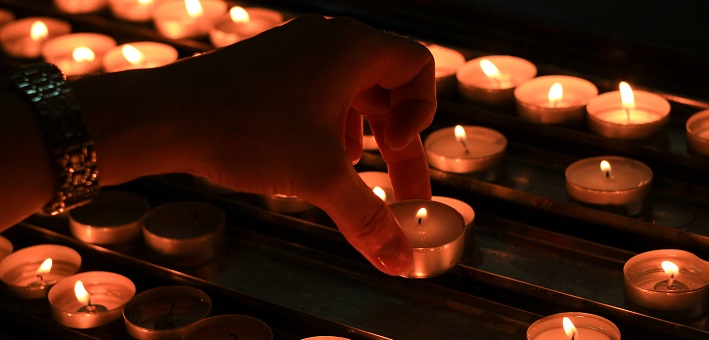Commentary on Matthew 28:1-10
As a layperson who considers preaching part of my calling, I am deeply curious how full-time pastors approach Easter Sunday. I believe I have preached Easter Sunday only twice, so I wonder whether full-time preachers feel the pressure to be clever, to say something new every year. One pastor told me exactly that recently.
[Looking for commentary on John 20:1-18? See this commentary for Easter Sunday by Gennifer Benjamin Brooks.]
One part of me thinks the best news needs no cleverness. We do not need the people we love most to tell us so in novel ways: just say the words, and I’m fine. Likewise, when it comes to Easter, “Alleluia! Christ is risen!” followed by a hearty, “Christ is risen indeed!” takes care of a whole lot. Give me a couple of classic Easter hymns, and I’m ready to bounce out the doors and head home.
The occasion sets some limits. Easter sermons usually can’t go too long due to unique liturgical circumstances. And traditionally, we preach to lots of people who are rarely present on Sunday mornings. It never hurts just to tell the good news that Jesus lives among us.
Yet Matthew offers its own distinctive take on the discovery of the empty tomb, as does each Gospel. Matthew opens a couple of questions: what signs mark Jesus’ resurrection, and how do we respond to that news?
Matthew goes big on the signs of Jesus’ resurrection. Among the Gospels, Matthew alone relates that the women experience an earthquake upon their arrival at Jesus’ tomb. Matthew attributes this earthquake to the arrival of an angel, who rolls back the stone and sits on it. Matthew’s wording suggests that angels make heavy landings. Apart from the simple fact that the tomb is empty, Matthew stands alone in attributing the stone’s removal to a miracle, at least explicitly.
Preachers have some room for productive theological play with their congregations here. When it comes to Easter, imagination matters, and folks vary greatly in terms of how their spirituality relates to the dramatic. The resurrection constitutes a great miracle on its own. But what signs do we need for it?
We might describe some listeners as rationalists. “Okay,” they might reason. “I can’t make any sense out of the idea of a resurrection. But I can relate to the sense that, even beyond the grave, Jesus still lives among us somehow.” That sensibility is not absent from Matthew, for whom Jesus is God with us (Matthew 1:23), present whenever two or more gather in his name (18:20), and abiding with the church as it continues his ministry (28:20). For these listeners, the earthquake and the angel function primarily as symbols relating to a deeper truth.
Some listeners will appreciate the earthquake and the angel as critical signs that God’s miraculous power has delivered Jesus from death. These hearers do not struggle with resurrection as a practical possibility but instead take strength in the signs that attest to it. This sensibility also runs through Matthew. For example, Matthew is fond of earthquake language. All three Synoptic Gospels refer to earthquakes among other eschatological portents (for Matthew, at 24:7). But Matthew alone uses earthquake language (seismos) to describe the “storm” on the sea, Matthew alone narrates an earthquake at the moment of Jesus’ death (27:54), and Matthew alone tells us about the earthquake at the tomb (28:2). In Matthew’s telling all these events hold revelatory, we might say apocalyptic, significance.
All the Synoptics mention angels in the plural. Matthew and Luke share appearances of an individual angel to direct and interpret the nativity story. But only Matthew and John place angels at the tomb, and only Matthew has the angel roll away the stone and speak to Mary Magdalene and the other Mary. (In Mark and Luke, mysterious men address the women at the tomb.) It is fair to say that Matthew emphasizes the dramatic, otherworldly dimensions of Jesus’ resurrection in unique ways.
Our hearers will interpret these dramatic manifestations in a range of ways. We may also ask how they will respond. In Matthew the two Marys respond in at least three ways: fear, joy, and obedience. Fear is precisely how a good biblical character responds to angels and other divine manifestations. Fear is also how mortals respond when we are confronted with a new truth that will change our lives. In this sense fear and joy are not strangers. We experience them when we draw close to a friend, when we fall in love, when a baby is on the way, and when sickness and death draw near. Why should not fear and joy accompany us when we are called to live into God’s good news?
Preachers will name, evoke, and walk alongside that fear in our hearers, even on Easter Sunday. Personally I find it easier to preach into that dynamic than I do joy. Recently the author George Saunders related how much easier it is to voice criticisms of someone’s writing than to offer detailed praise. I imagine something similar applies to preaching, where negative emotion is more accessible to us than a sublime experience like that of joy. But if we plumb those moments when joy and fear hold hands, perhaps we can reach our congregations with that reality.
Remarkably, the combined experience of fear and joy propels the two Marys to run and tell the other disciples. On the way they encounter the risen Jesus, who commands them to do precisely what they were already about to do. Fear, on its own, provides poor motivation for obedience. But joy, properly guided, makes us run to tell the story.


April 8, 2023